- New Sailboats
- Sailboats 21-30ft
- Sailboats 31-35ft
- Sailboats 36-40ft
- Sailboats Over 40ft
- Sailboats Under 21feet
- used_sailboats
- Apps and Computer Programs
- Communications
- Fishfinders
- Handheld Electronics
- Plotters MFDS Rradar
- Wind, Speed & Depth Instruments
- Anchoring Mooring
- Running Rigging
- Sails Canvas
- Standing Rigging
- Diesel Engines
- Off Grid Energy
- Cleaning Waxing
- DIY Projects
- Repair, Tools & Materials
- Spare Parts
- Tools & Gadgets
- Cabin Comfort
- Ventilation
- Footwear Apparel
- Foul Weather Gear
- Mailport & PS Advisor
- Inside Practical Sailor Blog
- Activate My Web Access
- Reset Password
- Customer Service

- Free Newsletter


Tartan 37 Used Boat Review

C&C 33 Mark II Used Boat Review

Island Packet 350 Used Boat Review
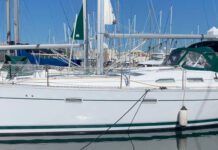
Beneteau 393 Used Boat Review

How to Create a Bullet-Proof VHF/SSB Backup

Tips From A First “Sail” on the ICW

Tillerpilot Tips and Safety Cautions

Best Crimpers and Strippers for Fixing Marine Electrical Connectors

Are Wrinkles Killing Your Sail Shape?

Superlight Anchors: Not Just for Racers

Refining Furling Line Fairleads
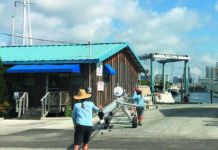
Revive Your Mast Like a Pro

Diesel-Electric Hybrids Vs. Electric: Sailing’s Auxiliary Power Future

Sailing Triteia: Budget Bluewater Cruising

How To Keep Pipe Fittings Dry: Sealant and Teflon Tape Tests

How Much Does it Cost to Own a Sailboat in Quebec,…

Anode Basics: Dos and Don’ts

What’s The Best Bottom Paint?

Boat Hook and Fender Hacks

Product Hacks: Velcro, Bounce, Anti-Skid Mats and Pool Lights


Stopping Holding-tank Odors

Giving Bugs the Big Goodbye

Galley Gadgets for the Cruising Sailor

Cold Weather Clothes to Extend the Sailing Season

Five Best Gloves: Sailing and DIYing in All Weather

Sailing Gear for Kids

What’s the Best Sunscreen?

R. Tucker Thompson Tall Ship Youth Voyage

On Watch: This 60-Year-Old Hinckley Pilot 35 is Also a Working…

On Watch: America’s Cup

On Watch: All Eyes on Europe Sail Racing

Dear Readers
- Sailboat Reviews
Catalina 22
For those to whom price is all-important,--the catalina 22 is appealing but it's lacking in performance..
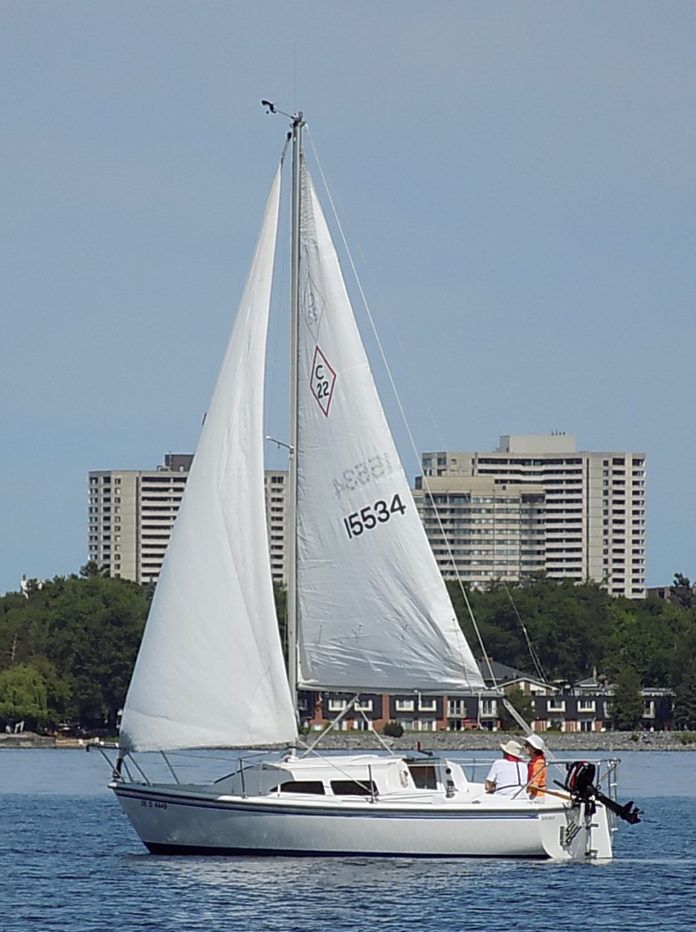
In its 10th anniversary issue in 1980, Sail magazine named the Catalina 22 the boat that had represented the breakthrough in trailer/cruisers in those 10 years. There is no denying the popularity of the Catalina 22: more than 10,000 of the model we review here have been built, and that doesn’t include the Sport models now being sold. For many buyers, the Catalina 22 is their first “big” boat and an introduction to the Catalina line. Many remain with Catalina and buy up within that line.
Catalina is the largest sailboat in the US in dollar volume, and the firm is one of the lasting success stories in the industry. It foregoes national advertising in favor of local dealer-sponsored ads, and has remained a privately owned company while the trend has been toward conglomerate-owned boatbuilding.
Like all manufacturing boatbuilders today Catalina builds boats to a price, making the most of volume buying of materials and hardware, long-lived models, a high degree of standardization, and all the cost savings of high volume production. The Catalina 22 was the first boat built by Catalina.
The Catalina 22 that we are reviewing here was in production from 1969 until 1995, when the Catalina 22 MkII was introduced. During this more than quarter-century of production, several incremental changes were made, with several significant upgrades in 1986, when a wing keel version was introduced.
The boat has been replaced by the Catalina 22 Sport. Introduced in 2004, the Catalina 22 Sport is still in production and it closely adheres to the original boat’s dimensions, and weight. Although the post-’95 boats have resolved many of the problems we find here in the original, they did so at the expense of a feature that racers admired—a lighter weight hull. So, although it might not have all the improvements of later models, the one we look at here will hold a certain appeal to sailors in areas that are home to active C22’s fleets, as well as to sailors looking to start sailing for under $5K, and aren’t afraid to put a little sweat equity into the boat.
Just as it was when the boat was first introduced, the Catalina 22 is a common landing spot for those who are just beginning to dream of an escape. It is to Catalina’s credit that the 22 continues to sell and continues to be many sailors’ first boat. And perhaps one of the biggest selling points of all, is the broad and consistent support in the form of other owners. There really isn’t anything that can’t be fixed on these boats, and dialed in, they can be fun to sail. One need only drop in on the website for Chip Ford to get an idea of what’s possible with this boat.
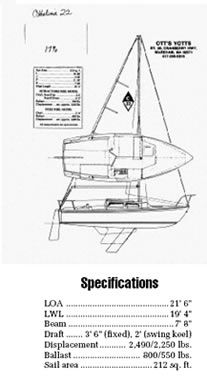
Construction
It’s hard to argue with the construction of a boat after 10,000 have been built, but we do. In these early boats the hull-to-deck joint— a plywood reinforced hull flange is joined to the deck with a rigid polyester “slurry” and self-tapping fasteners. This not our idea of ideal construction. The same type of joint is used on larger boats, although we are less concerned because obviously the structure is for a much smaller boat. Larger boats like the Catalina 30 also used this method, and the C30 has enough loyal followers to earn it a spot among our recommended 30-footers from the 1970s.
Catalina 22 has remained essentially unchanged from the day it was introduced in 1969. Only the pivot for the swing keel version was changed about boat #250 and then, according to a Catalina statement, it was done for production purposes. Later a pop-top option was added and now 90% of the boats sold have this feature.
Catalina takes credit for pioneering the one-piece hull liner that has become standard in most high volume small boats. However, it should be noted that the liner is basically a cosmetic component, not a structural member, and the hull must get its strength from the hull laminate and bulkhead reinforcement.
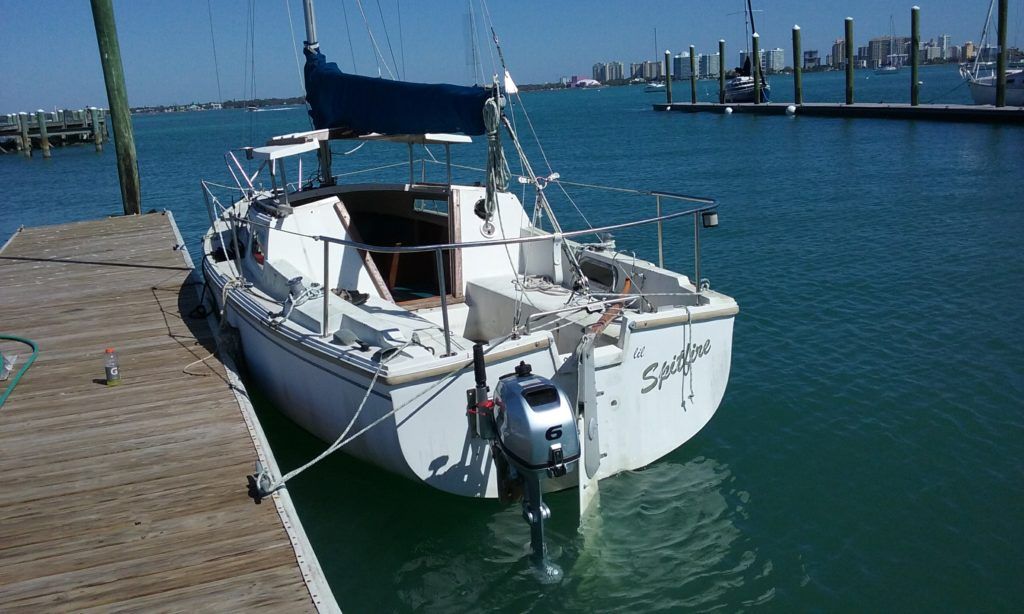
The swing keel, also chosen by 90% of the buyers, is cast iron and, when retracted, remains substantially exposed (accounting for more than half of the 2′ draft of the shoal draft model). It is a rough 550 lb. iron casting of indifferent hydrodynamic efficiency, but you can order templates for fairing quite easily.
The swing keel is hoisted with a simple reel winch located under a vestigial bridgedeck with its handle passing through a plywood facing. We’d guess that Catalina owners soon become conditioned to its presence, though it can trip those stepping up or down through the companionway.
The drop keel of the Catalina evoked a number of observations from owners in the PS boat owners’ questionnaire. Several note that the keel hangar mounting bolts loosen or seize. Another reports he had to replace his wire pennant twice. Replacing the pennant requires hoisting the boat high enough to have access to the top of the keel.
As with all Catalina-built boats, decor is a major selling point. The line, including the 22, is attractively appointed. They create a highly favorable impression which has to encourage sales, especially for first time boat buyers.
In fact, the Catalina 22 outside and inside is one of the most visually appealing small boats we have seen. It has enough trim and finish to look pretty. Similarly, her hull and rig, although dated, are well proportioned. It is about her performance and livability that we have the most serious qualms.
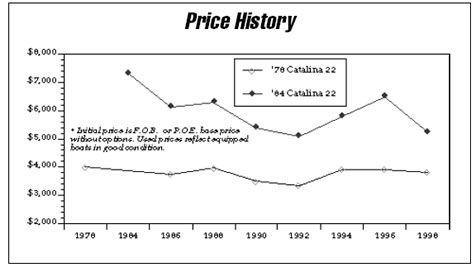
Performance
By any objective standard the Catalina 22 is hardly a sprightly performing small boat. There have been too many compromises to performance: trailerability, shoal draft, cockpit space, low cost, and interior accommodations, as well as giving her a placid disposition for novice sailors. The boat needs a genoa jib, a smoother, and more efficient swing or fin keel shape and some hardware of even the most modest go-fast variety. Even then the prognosis is that she will remain a rather tubby boat in an age when much of the fun of boats is in their responsiveness, if not speed.
With almost all the Catalinas having been built with the swing keel, the appeal has been her shallow draft for trailering. Yet even with 2′ of draft with the keel hoisted, the boat has too much draft for beaching. Given the tradeoff in performance, the difficulty of maintenance, and loss of stability, one hopes that indeed buyers of the swing keel 22 have made good use of it for trailering.
The deck of the Catalina 22 is a decidedly unhandy working platform. The sidedecks are narrow and obstructed by jib sheets and blocks. The three shrouds per side effectively block access to the foredeck, and complicate headsail trim and passage of the jib across in tacking. In fact, so difficult is it to go forward on the 22 we recommend getting rid of the lifelines. They are already too low to offer anything but token protection and they anchor near the base of the bow pulpit where they give no protection. Instead, handrails should be installed on the cabin top.
Ironically for a boat as popular as the Catalina, the boat incorporates the most incredible amount of wasted space we have ever seen in a sailboat large or small. In a size where stowage is at such a premium, there is a cavernous unusable space. The entire area under the cockpit and most of the area under the port cockpit seat (except where the gas tank sits) is all but inaccessible. The loss of this space limits stowage to scuttles under the berth bases.
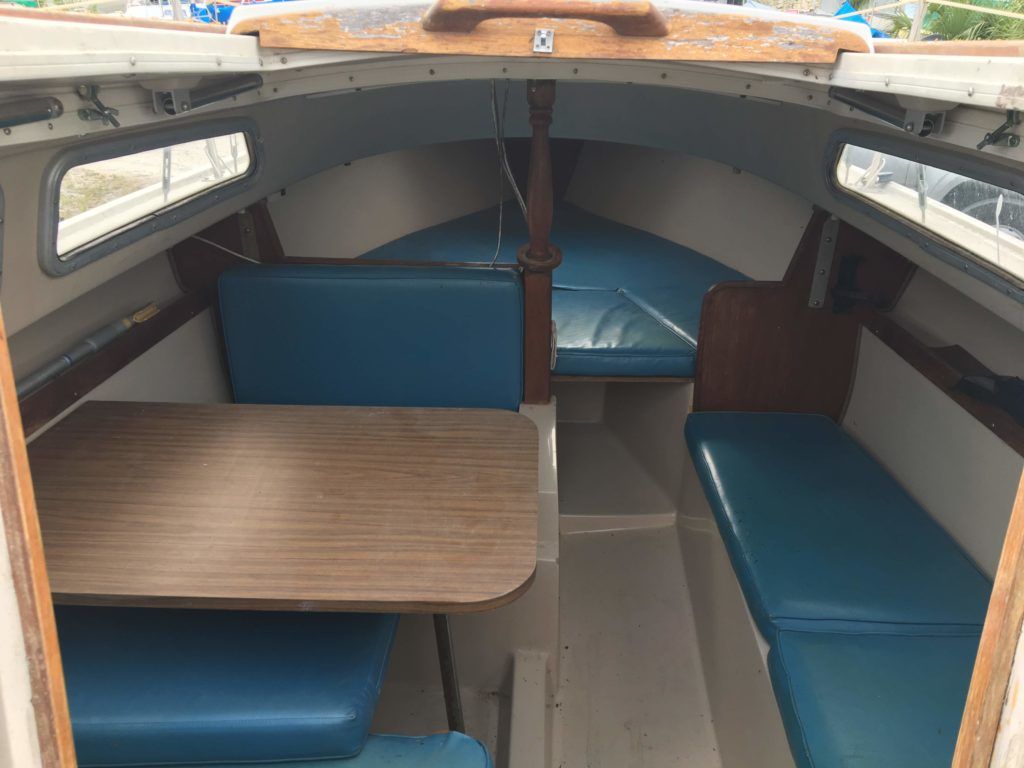
The convertible dinette which seats only two with elbow room is a vestige of the 22’s design era and the vee berths forward form that combination of bathroom and bedroom that is common on a daysailer of these dimensions. The alternatives, here, have their shortcomings.
The easy solution is to relocate the head to the cockpit when you finally decided to retire for the night. Otherwise, the settee on the starboard side, and even that berth is shared with the optional galley facility that in use takes up about half the berth area. The Catalina 22s now have a pop-top as standard; most of the cabin top lifts 10″ on four pipe supports. Most owners we have heard from seem to like the system, particularly those in warmer areas. Headroom at anchor is pleasant but we’d rather see room for stowage, sleeping, etc. as well.
One safety point in these older models that is worth raising is the stowage setup for the portable gas tank for a transom-mounted outboard auxiliary. The tank sits on a molded shelf (part of the hull liner) in a seat locker at the after end of the cockpit. This puts a portable gasoline tank inside the cabin.The locker is vented but it is not isolated. This arrangement can allow fuel can to make its way unimpeded to the inaccessible low point right under the cockpit. This design flaw has been corrected in later versions and if you have a boat with this arrangement, we recommend securing all portable tanks above deck until it is fixed.
One of the Catalina’s better features is her cockpit. It is long (7′) and comfortable, a place where the crew can sit with support for their backs, a place to brace their feet, and with room to avoid the tiller. It is unobstructed by the mainsheet that trims to a rod traveler on the stern.
Conclusions
Many boat buyers shop for a boat of this type with price foremost in mind. They probably will get no farther than their local Catalina dealer, where they can get a boat that is the same size and similarly equipped as boats costing far more. It’s apt to be a boat identical to many of those sailing on the same waters. Better still, they are more than likely to have sailing friends who not only have (or had) a Catalina but belong to one of the most widespread and active owners’ class associations in the sport. The whole package has a powerful appeal, especially to a newcomer seeking moral support.
For performance, accommodations and even construction they might do better at a higher price, but with Catalina’s proven staying power through decades of change, they understandably turn to the 22.
At a weight of about 2,500 lbs. loaded for the road plus a trailer, the Catalina 22 can be hauled by most cars. If anything but a jaunt to the boat ramp is envisioned, however, it’s big enough to recommend SUV with a trailer package.
RELATED ARTICLES MORE FROM AUTHOR
11 comments.
Still a useful review! FWIW, I was shopping for a Catalina 22 Sport at the Annapolis Boat Show last fall and Catalina was saying that they were close to $50,000 with common options and the wait time for a new one was 6 months. I realize that this is a small boat in the range of what is on the market at that boat show, but my goodness, were those sales people blasé about selling a boat to me. Ended up with a 5 yo boat for about half that much money. Unfortunately, she is still on the hard until spring in the Chesapeake!
Nice review of the Catalina 22. Out first boat was a Capri 22, which I was told was the “hot” version of the Catalina 22. It has a deep draft keel (6-7’?) and out-pointed every other boat on the lake. We slept aboard once….no fun!
This is a totally misleading article, focused entirely on exaggerated flaws. This article should really be written by someone who has actually owned a C22, and spent more than a cursory time sailing one. IMO, they’re great boats, and a ton of fun can be had with one – but only if the self-gratifying snobbism is left at the dock. The boat is squarely in the sweet spot of carrying costs and sailing fun.
These are great boats for beginners and sailors that want an uncomplicated boat to day sail and overnight on. I have taught ASA beginner classes on the C22. Also one of the popularities of this boat that was not touched on in this article is it’s one design racing class. Large fleets continue to turn out for weekend and national regattas.
No mention is made of stepping the mast. At 77 years of age and somewhat physically fit can I handle it?
Thanks, Bill Tucker
If the C22 is without a roller furler on the jib – stepping the mast is pretty light work. Check YouTube for videos on mast stepping a C22 – there are many good tricks and techniques to be learned. It can be stepped very easily by 2 people, or even just 1 person with a small bit of experience. On boats with a roller furler, stepping the mast is still not hard, but the roller furler acts like a 100 lb wet noodle, so it adds a bit of planning. I have a roller furler – but still, with the proper tricks, it can be done alone. Don’t be discouraged by this article – and I should add, almost all of the criticisms made only apply to the very early models, and the C22 additionally underwent a substantial redesign in 1986. Personally, between the 2, I favor the post 1986 boats, known as the “New design.”
IMO, it’s the best bang for the buck in sailing. It’s no small pleasure to know that as you enjoy the same wind, water and sun as the larger boats, you’re spending thousands less a season than literally everyone else. I could afford a larger boat, but for me – the smaller the boat, the bigger the experience one gets out of it. I’m in it for the love of being on the water. If you’re interested – check out the C22. https://forums.sailboatowners.com/forums/catalina-22.59/
i have a 2005 Sport I’ve owned since new. I’m old and gray, but yes, it’s doable to raise and lower the mast (I have hank on sails). I had a fella build me an folding A-frame that helps. I use the vang and jib halyard, attached at the top of the A-frame, to “lever” the mast up and down under control. I can also use the A-frame with my trailer winch and the halyard.
I love my Sport. Racing is getting behind me, so I’ve “comforted” it up a bit. I have a bimini (installed backwards so it folds forward out of the way for docking and getting underway). I added a “downhaul” retriever line up by the headstay. I attach the line to my genoa/jib so when it’s time to douse, I just “haul the sail down”. That holds it to deck, with the sheets pulled back safely, so that I don’t have to go forward. Winches were moved to the cabin top (helps with halyards, led aft), with ratchet turning blocks at the old winch locations. I can usually hand trim using the ratchet action. Only heavier winds require the winches. Backstay is partial spectra line for adjustment, and the traveler has controls in the cockpit.
I can single hand it all day.
I think the review was pretty harsh. These boats hold up well and sail to their rating. And the OD Class is awesome.
With a chain and a pulley using the main halyard, yes.
Fun to read this review. My parents got one in the mid-’70s and I “inherited” her. My wife and I spent our honeymoon cruise on her, later we packed our 3 kids and a dog in there for a 5-day cruise, and then I fixed her up again for a 25th anniversary honeymoon-reprise cruise. Not a fast boat, but to learn to sail and cruise? Perfect. And growing up cruising in such tight accommodations made the trimaran I have now gravitated towards (a reaction to sailing slowly?) quite tolerable. A perfect starter-boat. Mast-raising is easy if done carefully and slowly with appropriate gin-pole and some “baby-stay” guy wires: the trick is to get the baby-stays to rotate around the same point as the mast-base so they are tight all the way up. Or to have some help keeping the mast straight during raising.
The review does focus on many negatives, but missed the wicked weather-helm under some conditions. It took me years to realize I could simply move the center-of-effort aft by raising the swing-keel some, which helped immensely, despite seeming counter-intuitive (raise the keel to help upwind performance in high-wind conditions? Huh?). Don’t be scared off, but do inspect, for eg, the plywood cores for saturation and rot on older boats, and for signs of separation of the deck from the hull at the bow: I installed a turnbuckle from foredeck to the bow-ring to take the forestay tension when I fixed ours up. Cheers all.
That’s a great tip about the swing keel – makes perfect sense. A minor adjustment can make a difference in that regard.
Way back in about 1978 or so I made a new friend, Tony, that had purchased a Catalina 22 and was docked a few slips away from my dock, at the time, on lake Ontario at Wilson Boatyard in Wilson, NY, I was living on my new Challenger Ketch. Early one nite I noticed Tony on his Catalina 22. Tony was about 60 years old and knew almost nothing about sailing. We talked and he asked me to teach him how to sail his new 22″. We practiced sailing almost every nite with the evening offshore wind. He eventually got up enough confidence and courage to sail across Lake Ontario to Toronto Harbor on the North shore of the Lake where he and his 3 lady guest stayed on the boat and in a motel for a few days. Tony loved his Cataliona 22′.
LEAVE A REPLY Cancel reply
Log in to leave a comment
Latest Videos

J Boats J/9 Sailboat Review and Boat Tour

3 Tips for a Dry Boat – DIY Boat Maintenance 101

Jeanneau’s New Rule Breaking Sailboat – Sun Odyssey 350 Boat Review

A Fiberglass Cleaning Boat Hack You Have To Try!
Latest sailboat review.
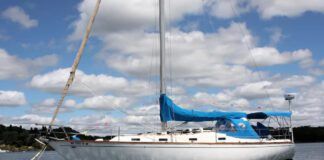
- Privacy Policy
- Do Not Sell My Personal Information
- Online Account Activation
- Privacy Manager

COMMENTS
A fixed keel version introduced in the early 1970's Draft: 3.5ft; Displacement: 2,490 lbs.; Ballast: 800 lbs. A 'New Design' was introduced in 1986 (featuring an opt. winged keel), and MARK II in 1995. The CATALINA 22 SPORT was released in 2003. (Originally called the CAPRI 22 swing keel.)
The Catalina 22 is an American trailerable sailboat that was designed by Frank V. Butler and first built in 1969. [1] [2] [3] [4] The Catalina 22 is one of the most produced boats in its size range and achieved an unparalleled commercial success. [1]
Inducted into the US Sailing Hall of Fame, the Catalina 22 is one of the most popular trailer sailers in the world. (AHunt, CC) In its 10th anniversary issue in 1980, Sail magazine named the Catalina 22 the boat that had represented the breakthrough in trailer/cruisers in those 10 years.
Welcome to the Catalina 22 National Sailing Association, the best source for organized Catalina 22 sailing activities and information about all models of the Catalina 22 sailboat. Whether you enjoy cruising, racing, or just messing around with your Catalina 22, scroll down for the latest announcements.
2022 Arey's Pond XFC22. Find 28 Catalina 22 boats for sale near you, including boat prices, photos, and more. Locate Catalina boat dealers and find your boat at Boat Trader!
View a wide selection of Catalina 22 boats for sale in your area, explore detailed information & find your next boat on boats.com. #everythingboats.